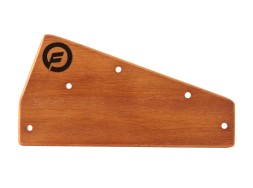MoogMinitaur Analog Bass Synthesizer Desktop Module
Item#
N12-1077
$599.00
- Free
Shipping - No Hassle
Returns - Extended
Warranty
Moog Minitaur
Moog’s Minitaur Analog Bass synthesizer is a compact but powerful desktop bass synthesizer based on the popular Taurus 3. The unit affords both MIDI and CV control but maintains an entirely analog signal path. One of the best qualities about the Minitaur is the expressiveness of its front panel, which features knobs governing every crucial parameter. There’s also a software editor available for even further editing potential.
Minitaur Features
- One knob per function interface for tweaking and creating new sounds on-the-fly
- Two oscillators with Sawtooth (Original Taurus) and Square wave-shapes for each VCO
- Recreate sounds of the original Taurus with sawtooth waves, or create new sounds with square waves, or combination of both
- 2 Mixer VCAs for VCO levels control of Oscillators 1 and 2
- Moog Ladder Filter with adjustable resonance delivers classic Taurus 1 and 3 bass and boom
- Two Minimoog style ADSR Envelope Generators for modulating VCF and VCA
- The Decay and Release segments are controlled by the Decay knob, while the Release segment is enabled or disabled via Release On/Off switch
- MIDI-syncable LFO with controls for Rate, VCO LFO Amount, and VCF LFO Amount
- DIN MIDI and MIDI over USB offer complete control of sound engine
- Analog Control inputs for Pitch, Filter, Volume and Gate
- Use an EP2 or CV to connect and control MInitaur with everything from Modulars to Moogerfoogers (sold separately)
- External audio input for processing external audio through the Mixer and Filter section
- Headphone output with 1/8" connection
Front Panel Controls
- VCO2 Frequency: Sets the frequency offset of VCO2 from VCO1 from -1 Octave to +1 Octave and center is unison with VCO1
- Oscillator 1 & 2 Saw/Square Waveform Selector: Selects a Sawtooth wave (LED OFF) or Square wave (LED ON) Signal for VCO1 and 2
- VCO1 Level: Sets the level of VCO1
- VCO2 Level: Sets the level of VCO2
- VCF Cutoff: Sets the Cutoff Frequency of the 4-pole Moog Lowpass VCF from 20Hz to 20KHz
- VCF Resonance: Sets the gain for the amount of signal from the output of the VCF fed back to the input of the VCF, creating a peak in frequency response at the
- Cutoff Frequency that can be increased all the way to self-oscillation
- VCF EG Amount: Bi-polar control sets the (+) or (-) amount of Envelope Generator modulation of the VCF and center is no Envelope Generator modulation
- LFO Rate: Sets the frequency of the LFO. Range is from 0.01Hz to 100Hz
- LFO VCO Amount: Sets the amount that the LFO modulates the VCO
- LFO VCF Amount: Sets the amount that the LFO modulates VCF
- VCA EG Attack: Sets the attack time of a Minimoog-Style ADSR Envelope Generator used to modulate the VCA (ranges from 1 msec to 30 sec)
- VCA EG Decay/Release: Sets both the decay time to the sustain level and release time of a Minimoog-Style ADSR Envelope Generator used to modulate the VCA (ranges from 1 msec to 30 sec) and Release segment of the EG is enabled by the Release On/Off switch
- VCA EG Sustain: Sets the sustain level of a Minimoog-Style ADSR Envelope Generator used to modulate the VCA
- VCF EG Attack: Sets the attack Time of a Minimoog-Style ADSR Envelope Generator used to modulate the VCF (ranges from 1 msec to 30 sec)
- VCF EG Decay/Release: Sets both the decay time to the sustain level and release time of a Minimoog-Style ADSR Envelope Generator used to modulate the VCF (ranges from 1 msec to 30 sec) and Release segment of the EG is enabled by the Release On/Off switch
- VCF EG Sustain: Sets the sustain level of a Minimoog-Style ADSR Envelope Generator used to modulate the VCF
- Release On/Off Switch: Enables (LED On or disables (LED Off) the Release segments of both Envelope Generators
- Glide On/Off Switch: Enables/ Disables the Glide function
- Glide: Sets the rate of Glide when the note controlling the MINITAUR changes
- Volume: The Master Volume of the MINITAUR’s synth Engine
- Fine Tune: Adjusts the frequency of the VCOs +/- 1 semitone
- MIDI Indicator LED: Indicates incoming MIDI activity
- LFO Rate Indicator LED: Indicates the rate of the LFO
Back Panel
- Audio Out: 1/4" unbalanced jack
- Headphones: Jack for stereo headphone output
- Audio In: 1/4" unbalanced jack accepts line-level input
- Analog CV Inputs
- Pitch CV: 1/4" TRS Jack accepts 0 to +5V signal (internally processed for 1 V/Octave) via passive Expression Pedals or CVs
- Filter CV: 1/4" TRS Jack accepts 0 to +5Vsignal via passive Expression Pedals or CVs
- Volume CV: 1/4" TRS Jack accepts 0 to +5Vsignal via passive Expression Pedals or CVs
- Gate: 1/4" Jack accepts a 0 (Off)/ +5V(On) Gate signal to trigger the unit’s EGs
MIDI
- MIDI (DIN): Standard DIN MIDI input for MIDI Control of the MINITAUR
- MIDI (USB): Type B USB connector for connecting MINITAUR to host for USB MIDI
Moog Minitaur Analog Bass Synthesizer Desktop Module Reviews


